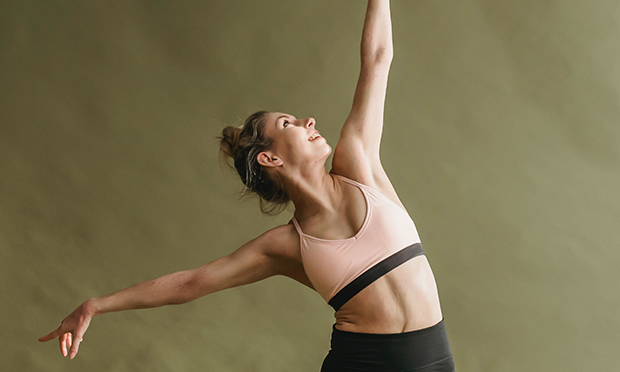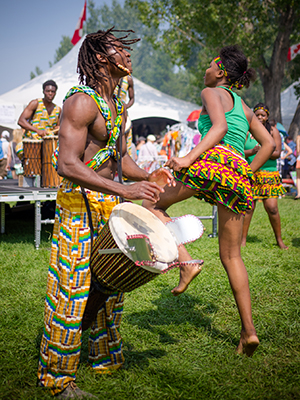Movement Medicine

Movement practice in action
I like to say that I was born dancing. My childhood memories are peppered with rehearsals, shows and competitions, even before kindergarten. Back then, they used to call me Janet Jackson. Yes, THE Janet Jackson. Even now my seven-year-old son’s daily request is for me to teach him how to moonwalk. It has become my badge of coolness, the first thing he blurts out when making a new friend: “Hi, my name is Daniel and my mum can do the moonwalk.” Hashtag ‘cool mum’ please, thank you!
African traditional dance is bold, sensual, and riveting. Its shaky-shakiness makes you burst with untamed energy like fireworks in a bottle. My work as a traditional African dancer and choreographer is a creative tsunami. My body is overtaken by a sea of dance steps that crash against the shore of my senses before waving themselves out through my legs, stomping, my waist whining, or my back slithering. It is a magical ebb and flow that I eagerly anticipate and surrender to every single time.
Yet, more and more I find myself favouring the grounding, subtleness and depth of my Sacred Movement Practice. Sacred because we live in a world in which having no time for yourself validates whatever you are doing. We huff and puff on the wheel of fortune, standing ourselves up again and again in the name of betterment, so much so that intentionally carving time out for yourself is now a luxury. On the rollercoaster of modern life, my movement practice has become my refuge, my medicine and my therapy, a time within time that allows me to move onwards and upwards with minimal stress.

Traditional dancing in Cameroon
Dance is movement, but moving is not always dancing. When I create a dance routine, steps are arranged in a particular order and that structured flow should also be pleasing to the eye. On the other hand, my movement practice is totally uninhibited. The flow is primal, loose and raw, completely intuitive and unstructured, with zero concern for aesthetics. It is a tête-à-tête with myself, where movements take me deep within the conscious and unconscious recesses of my body.
The body is the receptacle of our life experiences, forever witnessing and recording every single story, trauma, loss and celebration. I believe that our stories are not just in our heads but written and preserved in our cells.
‘Movement has always been used to commune with the inner self’
Movement is the natural language of the body, so through movement you can release or read those untold or forgotten stories. A movement practice is you – with you, for you and by you. And it does not have to be a grand affair.It could be as basic as walking or as elaborate as Tai Chi.
What matters is the intention to be with your gloriously naked and authentic self, flaws and all.
My personal practice and one-to-one sessions are preceded by rituals, chanting, and sacred smoke, amongst other things. This reflects my spiritual lineage, made up of African shamans, medicine women and Sacred Dancers. Where I come from, movement has always been used to commune with the inner self, not only because it is the natural expression of the human body but also because it is energy in motion and we are energy. With movements, we can harness that energy and give it direction, bypassing flesh and bone to dive deep within the subtle realms of the body. That’s where your truth lies, away from society’s games of thrones.
When chemotherapy battered every ounce of vitality out of me, my movement practice helped me. Loss of balance and dizziness had become my new normal, but still I would retreat within through basic movements such as shoulder rolls, letting go of old and sick energy. Doing this allowed me to feel myself again, and to know that the Red Devil drug had not broken me. I am still here.
Whenever possible, I have tried during chemo to walk barefoot at the park or at home, pressing my soles firmly against the ground, visualising Mother Nature infusing every single step with energy and enduring love. I prepared my body for mastectomy through chest opening movements, with the aim of welcoming the surgery and not viewing it as a mutilation, for resistance causes friction and with friction comes trauma. Those tiny and basic movements loaded with intention sustained my body and mind. I had to shut out the external world to truly experience my inner world.
But wait, there is another word for it: meditation. Shall we say a moving meditation? Meditation is not not thinking. To me, it is contemplating, engaging with and listening to the self. This could be achieved through your traditional sitting posture, or in my case, through movements. Whether that movement consists of toes wiggling or arms flapping, it does not matter. You are still a winner.
For those of us needing a little push to start moving, a few organisations have amazing offerings across the borough – all free. There is the Monday Wellbeing Club at the Round Chapel in Clapton, a plethora of movement and dance sessions offered by Kings Park Moving Together, such as chair disco, yoga, nature walks, and my own Afrofit dance sessions. Get moving!
Joelle is a dancer, storyteller and mystic who lives in Hackney. For more information about her work, visit joellebantu.com.
